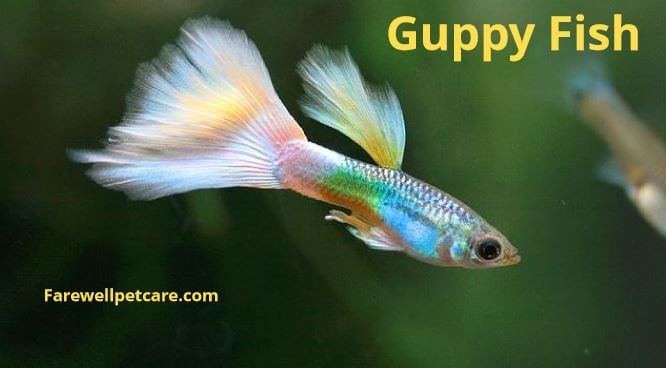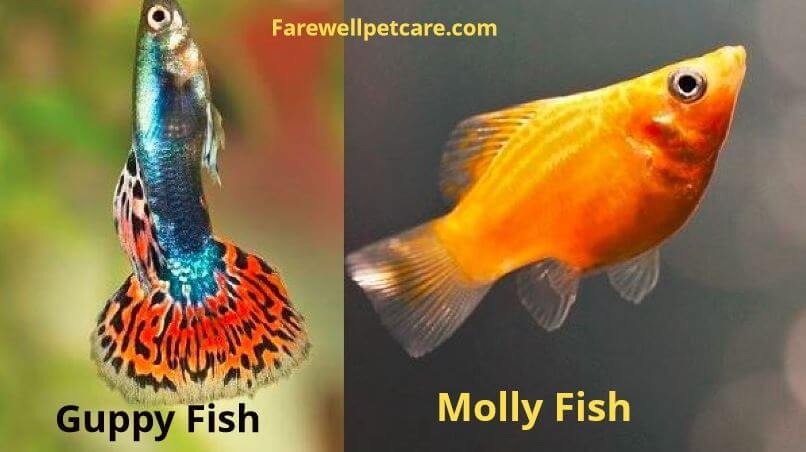Breeding molly fish with other livebearers is an inviting prospect with exciting possibilities and unique outcomes. One of the most curious questions many aquarists ask is, “Can guppies breed with mollies to produce a hybrid?”
Guppies can breed with mollies to produce a hybrid if the breeding happens under the right temperature and water conditions. A male molly breeding with a female guppy produces a hybrid called Muppy. In contrast, a male guppy breeding with a female molly gives a hybrid called Golly.
Keep reading to know how you can crossbreed a guppy and a molly, how to take care of the hybrid, and the challenges involved in this kind of breeding if you do it incorrectly.
What Is a Guppy?

A guppy is a livebearer fish species staple to many aquariums worldwide. Scientifically known as Poecilia reticulata, guppies are native to South America.
In terms of size, these fish grow up to 2 inches (5.08 cm) in captivity. They enjoy freshwater aquariums where they can live happily for 2-3 years before dying.
Guppies are peaceful. They can live with other livebearers without fighting. Additionally, they love living in shoals, as these groups create a sense of belonging and security.
Moreover, guppies boast limitless color variations; males are vibrantly colored, while females have a more brown coloration.
Male guppies are smaller and have slender bodies with long, tapering anal fins. They also have more prominent dorsal and caudal fins. On the other hand, females have large and triangular anal fins.
The fish are usually sexually mature after 2-3 months. You can effortlessly identify male and female guppies at one month of age.
Loved by beginner aquarists, guppies are easy to keep. Reasons for being the best beginner aquarium fish include:
- They can tolerate poor conditions.
- Guppies are cheap to maintain.
- They multiply fast
Considering the final point, make sure you separate the males and females. Otherwise, population explosion is a common problem many guppy parents have had to deal with after a moment of slumber.
Find Out: How Many Mollies Should Be Kept Together? 6 Important Factors to Consider
Similarities Between Guppies and Mollies
Here are the similarities between guppies and mollies that you should know:
- They both belong to the fish family Poeciliidae. This family consists of small livebearer fish that live in freshwater environments.
- While guppies are native to South America, mollies also hail from the same region. In addition, mollies also originated from Central America in Mexico and Colombia.
- Both fish prefer freshwater habitats, although they can adapt to various environments, making them suitable for many aquariums.
- Guppies and mollies have a lifespan range of 2-5 years and 3-5 years, respectively, on average.
- Both are small fish.
- Both fish have an omnivore diet, meaning they can feed on plant matter and small insects. In aquariums, you can feed them high-quality fish flakes, live or frozen foods, and vegetables.
- Both guppies and mollies are livebearers. They reproduce by giving birth to live fry instead of laying eggs. Females usually hatch eggs within their bellies, and the fry fully develops before birth.
- Both have vibrant and striking color variations. That said, females have a brown coloration and, therefore, dull.
- Guppies and mollies are social and active fish. This explains why they love moving in shoals. Hence, keeping only one guppy or molly in the aquarium is not humane.
- Both guppies and mollies relish and thrive in slightly alkaline water conditions.
- The fish are popular in community aquariums thanks to their peace-loving nature.
What Is the Difference Between Golly and Muppy, and Which Is Safer?
The difference between Golly and Muppy is that Gollies are produced when a male guppy mates with a female molly, while a Muppy is an offspring produced when a male molly mates with a female Muppy. Gollies are safer than Muppies because they don’t risk their mother Molly’s life.
Female mollies are usually large and can easily carry offspring until delivery. On the contrary, female guppies are small compared to mollies. If you breed them with male mollies, your guppy may experience adverse pregnancy complications that can be fatal.
Gollies are healthier and stronger than muppies. Therefore, you should be ready for health problems like gill flukes and gill disease if you want to raise Muppies.
In that regard, raising Gollies and Muppies requires a lot of attention. You should keep their environment always clean to ensure they don’t get infected. Moreover, maintaining the correct tank parameters is critical to the survival of your gollies and muppies.
Note that both gollies and muppies are sterile. Therefore, you should not expect to breed them further.
Also Read: Molly Fish Eye Bulging: 3 Causes and Their Remedies
How to Breed a Male Guppy With a Female Molly

You can breed a male guppy with a female molly by following the next steps. However, you should know that the resulting offspring may have serious health issues. Thus, be careful with the entire process.
1. Transfer the Pregnant Female Mollies to the Breeding Tank
If you want to help your pregnant molly fish live stress-free lives, transfer them into a breeding tank. This tank should not have males or other aggressive fish that can distract the expectant mothers.
The pregnant fish will spend between 28 and 60 days in the tank before giving birth. Gestation periods vary from fish to fish and species to species. Therefore, expect a longer or shorter pregnancy since you expect mixed-breed offspring.
Don’t forget to remove the females from the tank once they give birth to prevent them from eating the fry.
2. Provide Ideal Water Conditions
The key to successfully breeding a male guppy with a female molly is providing the right water conditions. Both parents should be stress-free, so providing the perfect water conditions is vital.
Fortunately, both fish enjoy living in similar water conditions. Check on the following water parameters:
Water Temperature
For a stable environment, keep the water temperature between 70-76℉ (21-24℃). Warm temperatures are perfect for your fish—these are tropical fish that love moderate warmth.
A thermometer comes in handy in determining if tank temperatures are within the ideal range. You can adjust the temperature accordingly depending on the prevailing aquarium conditions.
Check on Water Parameters
Both species favor slightly alkaline water conditions. Hence, maintain a pH range of 7.5 to 8 for the mates. Similarly, keep a moderate water hardness between 12-18 dGH.
Ensure the breeding tank has no impurities such as ammonia and nitrites. In addition, keep track of all parameters regularly to avoid impurities accumulating behind your back.
3. Parent Fish Selection
Take time to select the fish with desired characteristics to become parents.
It’s recommended to consult your veterinarian or an experienced aquarist to help choose superior parents.
In that context, select two male guppies and six female mollies. Don’t mix sexes in guppies and mollies. For instance, don’t have a few male guppies and male mollies mixed with a few female mollies and female guppies.
This scenario presents an excellent opportunity for same-species breeding. Naturally, guppies would prefer mating with other guppies; the same happens with mollies.
4. Allow the Parents to Mate
Once you have mixed the fish, wait for them to mate. It might take some time for the fish to breed successfully because it’s a game of hide and seek.
But once they mate, some sperm is stored in the female and can continue serving her for six months. Fertilization occurs immediately, leading to conception and embryo development.
A pregnant molly will exhibit specific symptoms like increased appetite, aggression and hiding behavior, and general inactivity.
Factors to Consider When Raising Gollies

Guppy-molly hybrids are easy to breed but require a lot of attention. Here are factors you should consider when raising gollies.
- Health problems: Golly hybrids are essentially weaker than their parents. They suffer low immunity and are more prone to common fish diseases and conditions.
- Reproduction: If you don’t want to perpetuate your guppy or molly fish line, raising gollies is an excellent option. This is because hybrids are usually infertile and, therefore, unable to reproduce.
- Water parameters: Make sure to provide the best water parameters possible to avoid impurities that may kill hybrids fast. Never allow any nitrites and ammonia traces in the tank. These are hybrids and can’t survive a slight breach of conditions.
- Diet: Provide a high-quality diet for the fish. The diet should be well-balanced and consistent. Offer high-quality commercial flake food, live, and frozen foods. Basically, the diet is similar to what parents feed on.
How Do You Tell If a Molly Is Male or Female?
You can tell if a molly is male or female by looking at the anal fin, gravid spot, temperament, size, and body shape. Here is how to assess these features:
- Anal Fin: While both genders have an anal fin, males’ anal fins extend into a gonopodium. The gonopodium appears long and pointy, resembling a tube. It’s used for reproduction. On the other hand, females have regular, fan-shaped anal fins.
- Gravid Spot: The gravid spot is only present in females. You can closely observe it as a dark spot area near the anal fin. It’s also a reproductive organ that becomes darker when the fish is in the later pregnancy stages.
- Size and Body Shape: Male mollies are usually longer and slender, while females have slightly rounded and plumber bodies.
- Temperament: Males are more active than females. They also chase females during mating, and they can dance. On the contrary, females are docile, preferring to hide and rest.
So, Can Guppies Breed With Mollies to Produce a Hybrid?
After exploring the question, “Can guppies breed with mollies to produce a hybrid?” it’s clear that the answer is a resounding Yes!
Depending on the gender of the parents, breeding mollies and guppies produces gollies and muppies. Of the two, gollies are highly preferred because they’re healthier than muppies.
If you want to breed a male guppy and a female molly successfully, provide optimum water conditions, temperature, and diet.

